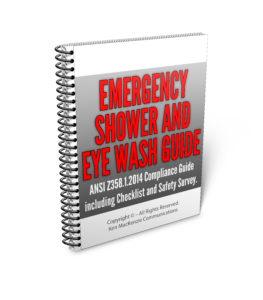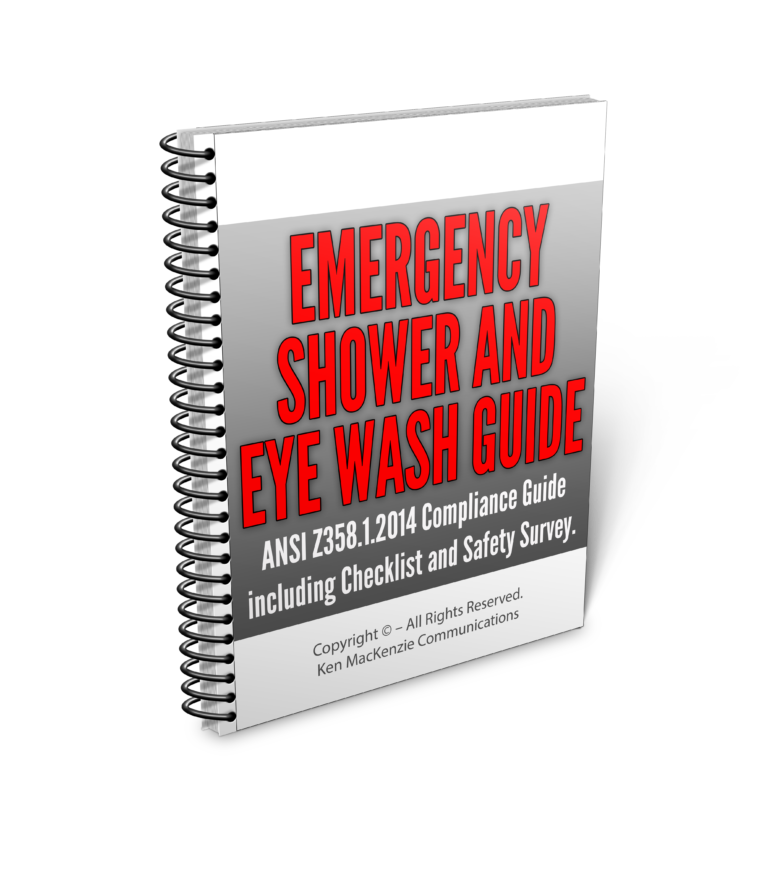Table of Contents
Essential Emergency Shower and Eyewash Station Checklist
Protect Your Workplace Safety – Critical Steps
- There must be an unobstructed travel path between the hazard and the emergency shower drench. The emergency shower drench must be installed within 10 seconds of the danger and on the same level as the hazard.
-
The water delivered by the emergency shower drench unit must be tepid (lukewarm).
- In this regard, see the Emergency Shower and Eye Wash Guide.
- The emergency shower station should provide 20 gallons (75.7 liters) of water per minute for 15 minutes.
- The “hands-free” stay-open valve has to activate in one second or less.
- The water supply has to be sufficient to supply at least 20 gallons per minute in the required pattern for 15 minutes.
- There has to be an easily accessible actuator and not be higher than 69 inches (173.3cm) above the floor.
- The emergency shower unit has to be identified with a highly visible sign and the area well-lighted.
- The emergency shower unit should be activated at least weekly.
The 15-minute flush tip: Don’t forget to install a floor drain or some other means of fluid disposal that complies with local, state and federal codes. There can be a lot of water to clean up if forgotten.
Consistent activation makes the difference between meeting minimum requirements for installed products and having emergency equipment that is truly functional and provides the best performance in an emergency.
Eyewash checklist
- The eye wash unit must be within 10 seconds of the hazard on the same level as the hazard and within an unobstructed travel path.
- The water delivered must be tepid (lukewarm) from the eye wash station. Again, please see the Emergency Shower and Eye Wash Guide.
- The valve actuator must be easy to locate and readily accessible to the user.
- The flushing fluid should be tepid and in the range of 60 degrees F to below 100 degrees F. The output flushing fluid must be within that range immediately at start-up of the equipment and remain there throughout the full 15-minute use cycle.
- There should be a controlled, low-velocity flow, that rinses both eyes and is not injurious to the user.
- The spray head should be protected from contaminants.
- The eye wash unit must deliver at least 0.4 gallons (1.5 liters) of water per minute for 15 minutes.
- A ‘hands-free’ stay-open valve must activate in one second or less.
- The eye wash unit should be connected to an uninterruptible water supply delivering 0.4 GPM.
- A highly visible sign should identify the eyewash and the unit should be well lighted.
 Emergency Shower and Eye Wash Checklist Inspection Tag:
Emergency Shower and Eye Wash Checklist Inspection Tag:
It’s a good idea to have an Inspection Tag attached to each emergency fixture noting activation as this log also serves as important documentation upon plant inspection.
Employees must be instructed in the location and receive training in the use of the emergency shower and/or eyewash station.
Current Emergency Shower Checklist Standards:
Current standards (ANSI Z358.1 sections 4.6.2 & 4.6.5) require weekly activation of emergency showers and eyewashes to confirm proper operation, along with a thorough annual inspection.
While ANSI Z358.1 establishes many additional requirements, the standards identified above are commonly overlooked. Each month, OSHA publishes a recap of noted violations and related fines levied against companies; financial penalties for non-compliance often begin at $100,000 and can exceed $1 million.
Costly Emergency Shower Checklist Errors:
In today’s “lawsuit lottery” business climate, even a rich imagination is no match for jury-based settlements.
ANSI Z358.1 – Emergency Shower Checklist and Eye Wash Checklist – Frequently Asked Questions:
1. With the recent revisions to the ANSI standard, are existing eyewash, shower, and drench hose stations required to meet the guidelines?
Yes. No grandfather clause in the Z358.1 Standard allows the equipment to be exempt. As the standard changes, existing shower equipment needs to be updated.
2. Does OSHA use the ANSI standard?
OSHA requires the employer to provide suitable facilities for quick drenching or flushing of the eyes. While OSHA has not formally adopted ANSI Z358.1, they refer employers to the standard as a source of guidance. It is the employer’s responsibility to assess the particular conditions related to the needs of the site to ensure the eye/face wash and shower unit(s) provide suitable protection for employees.
3. Does the annual testing require a full 15-minute flow?
Yes. The importance is to ensure tepid water throughout the full 15 minutes as well as maintain the pressure and shower patterns.
4. What is the difference between an eye/face wash and just an eyewash?
An eyewash is specific to the eyes, and the water flow rate is designed to hit only the eye surface, while an eye/face wash will cover the eyes and a portion of the face. In addition, an eyewash has a .4 GPM (1.5 LPM) minimum flow rate and an eye/face wash has a 3.0 GPM (11.4 LPM) minimum flow rate.
5. Does the simultaneous requirement for shower activation apply to multiple stations?
Those responsible for the health and safety of the area will determine what the potential is for an accident and how many people could be exposed. Once that number is determined, a system is designed for that number of showers and eyewashes to run simultaneously. For example: if a facility has ten showers within a specific area and is required to have two running at the same time, then two showers must be designed to simultaneously activate properly.
6. Are there guidelines for the placement of eye/face wash stations within a building?
The ANSI standard states that the eye/face wash needs to be 10 seconds away from where an accident could occur and needs to be on the same level with no obstructions. For strong acids or strong caustic, the emergency equipment should be immediately adjacent to the hazard.
7. Is there a distance conversion?
The current ANSI Standard states that the drench equipment must “be in accessible locations that require no more than 10 seconds to reach.” The appendix of the ANSI Z358.1 Standard clarifies stating “that the average person covers a distance of approximately 55 feet (16.8 m) in 10 seconds.”
8. Learn more at Emergency Shower and Eye Wash Guide.
You should refer to the American National Standard ANSI Z358.1-2014 ” Emergency Eye Wash and Shower Equipment ” for a full list.


